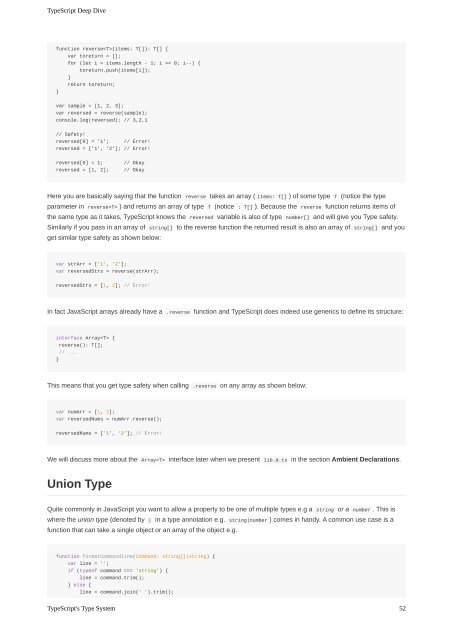Typescript Deep Dive by Basarat Ali Syed
Typescript Deep Dive by Basarat Ali Syed
Typescript Deep Dive by Basarat Ali Syed
You also want an ePaper? Increase the reach of your titles
YUMPU automatically turns print PDFs into web optimized ePapers that Google loves.
TypeScript <strong>Deep</strong> <strong>Dive</strong><br />
function reverse(items: T[]): T[] {<br />
var toreturn = [];<br />
for (let i = items.length - 1; i >= 0; i--) {<br />
toreturn.push(items[i]);<br />
}<br />
return toreturn;<br />
}<br />
var sample = [1, 2, 3];<br />
var reversed = reverse(sample);<br />
console.log(reversed); // 3,2,1<br />
// Safety!<br />
reversed[0] = '1'; // Error!<br />
reversed = ['1', '2']; // Error!<br />
reversed[0] = 1;<br />
reversed = [1, 2];<br />
// Okay<br />
// Okay<br />
Here you are basically saying that the function reverse takes an array ( items: T[] ) of some type T (notice the type<br />
parameter in reverse ) and returns an array of type T (notice : T[] ). Because the reverse function returns items of<br />
the same type as it takes, TypeScript knows the reversed variable is also of type number[] and will give you Type safety.<br />
Similarly if you pass in an array of string[] to the reverse function the returned result is also an array of string[] and you<br />
get similar type safety as shown below:<br />
var strArr = ['1', '2'];<br />
var reversedStrs = reverse(strArr);<br />
reversedStrs = [1, 2]; // Error!<br />
In fact JavaScript arrays already have a .reverse function and TypeScript does indeed use generics to define its structure:<br />
interface Array {<br />
reverse(): T[];<br />
// ...<br />
}<br />
This means that you get type safety when calling .reverse on any array as shown below:<br />
var numArr = [1, 2];<br />
var reversedNums = numArr.reverse();<br />
reversedNums = ['1', '2']; // Error!<br />
We will discuss more about the Array interface later when we present lib.d.ts in the section Ambient Declarations.<br />
Union Type<br />
Quite commonly in JavaScript you want to allow a property to be one of multiple types e.g a string or a number . This is<br />
where the union type (denoted <strong>by</strong> | in a type annotation e.g. string|number ) comes in handy. A common use case is a<br />
function that can take a single object or an array of the object e.g.<br />
function formatCommandline(command: string[]|string) {<br />
var line = '';<br />
if (typeof command === 'string') {<br />
line = command.trim();<br />
} else {<br />
line = command.join(' ').trim();<br />
TypeScript's Type System<br />
52


















